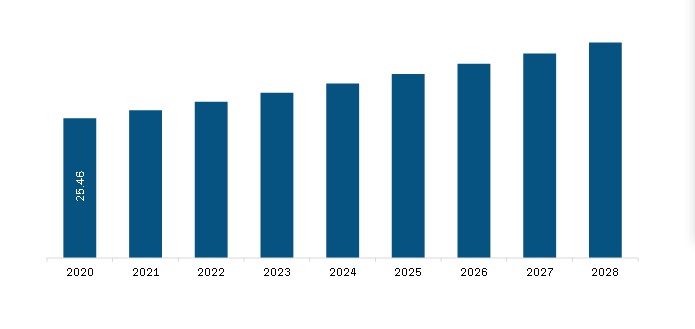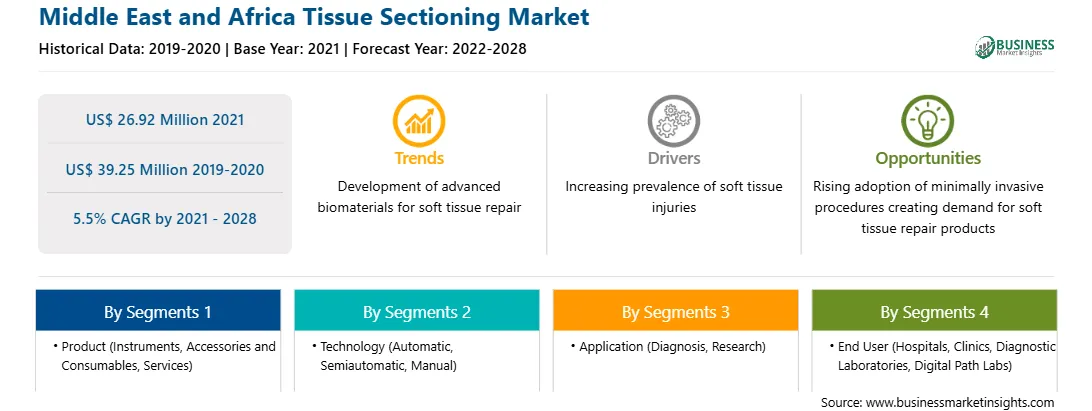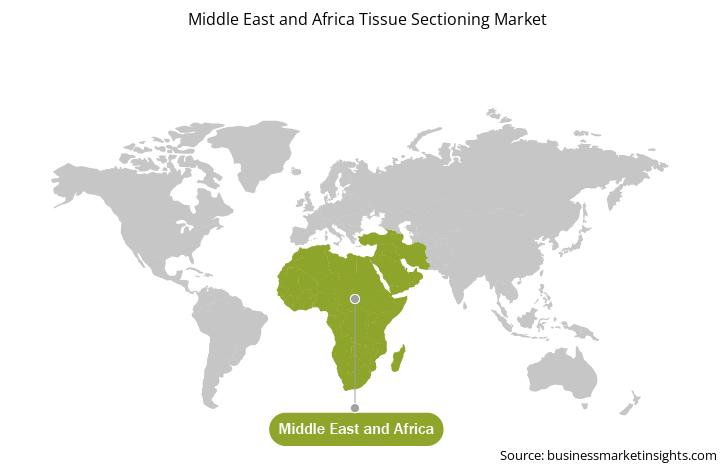Market Introduction
Tissue sectioning is a procedure that involves cutting tissues into thin sections so that they can be placed on a slide and then mounted under a microscope for study. It is used to examine tissue in order to detect any abnormalities or disease conditions. It is employed in histology laboratories, science laboratories, and other settings. Tissue processing is carried out after it has been examined between tissue embedding and fixation. Frozen sectioning and paraffin sectioning are the two types of tissue sectioning. It is used to detect breast nodules to determine whether a mastectomy is necessary, as well as to treat congenital megacolon in children and newborns. For advanced analysis, the tissues to be sectioned must be cut into very thin pieces or sections, i.e., 5-10 micrometer or smaller portions.
Strategic insights for the Middle East and Africa Tissue Sectioning provides data-driven analysis of the industry landscape, including current trends, key players, and regional nuances. These insights offer actionable recommendations, enabling readers to differentiate themselves from competitors by identifying untapped segments or developing unique value propositions. Leveraging data analytics, these insights help industry players anticipate the market shifts, whether investors, manufacturers, or other stakeholders. A future-oriented perspective is essential, helping stakeholders anticipate market shifts and position themselves for long-term success in this dynamic region. Ultimately, effective strategic insights empower readers to make informed decisions that drive profitability and achieve their business objectives within the market. The geographic scope of the Middle East and Africa Tissue Sectioning refers to the specific areas in which a business operates and competes. Understanding local distinctions, such as diverse consumer preferences (e.g., demand for specific plug types or battery backup durations), varying economic conditions, and regulatory environments, is crucial for tailoring strategies to specific markets. Businesses can expand their reach by identifying underserved areas or adapting their offerings to meet local demands. A clear market focus allows for more effective resource allocation, targeted marketing campaigns, and better positioning against local competitors, ultimately driving growth in those targeted areas.
Middle East and Africa Tissue Sectioning Strategic Insights

Middle East and Africa Tissue Sectioning Report Scope
Report Attribute
Details
Market size in 2021
US$ 26.92 Million
Market Size by 2028
US$ 39.25 Million
Global CAGR (2021 - 2028)
5.5%
Historical Data
2019-2020
Forecast period
2022-2028
Segments Covered
By Product
By Technology
By Application
By End User
Regions and Countries Covered
Middle East and Africa
Market leaders and key company profiles
Middle East and Africa Tissue Sectioning Regional Insights

Market Overview and Dynamics
The Middle East and Africa (MEA) tissue sectioning market is expected to reach US$ 39.25 million by 2028 from US$ 26.92 million in 2021. It is estimated to grow at a CAGR of 5.5% from 2021 to 2028. The increasing prevalence of chronic diseases and the rising adoption of personalized medicines are propelling this regional market. However, the lack of skilled professionals is expected to restrict the market growth during the forecast period.
Personalized or precision medicine has become the hallmark of treatment for various severe diseases and has expanded to other fields with its application. It is a constantly emerging approach to customizing therapies based on patients' genetic accumulation. These technological advancements have led to tissue sectioning approaches that achieve better results with the available resources in less time. For the prevention and efficient treatment of a disease, personalized medicines are mandatory tools, especially in oncology and nephrology cases.
The rapidly increasing cancer cases indirectly contribute to this market. For instance, as per the WHO, cancer is a leading cause of death worldwide, accounting for nearly 10 million demises in 2020. The most common types of cancer are lung cancer, liver cancer, blood cancer, and breast cancer. Between 30% and 50% of cancers can currently be prevented through early cancer diagnosis and appropriate treatment and care of patients. According to the WHO, several types of cancers are likely to be cured if diagnosed early and treated appropriately. The increasing use of personalized medicine has prompted the use of human tissue use to foster innovative tests.
The Middle Eastern countries are severely affected by the COVID–19 pandemic. The countries in these regions are highly dependent on imported medicinal products from developed countries. The lockdown has affected the supply chain of various companies in these regions. However, as the crisis continues and government relaxations on the import of medical products are expected to witness significant growth in orders.
The demand for tissue sectioning systems tended to decrease from the outbreak of COVID-19; however, pharma companies have begun to work on developing strategies to sustain the histopathology procedures. According to experts, data obtained from COVID-19 case-studies, such as severe acute respiratory syndrome (SARS) and the Middle East respiratory syndrome (MERS), 70% ethanol and 0.1% sodium hypochlorite should inactivate the virus. As used in routine tissue processing, formalin fixation and heating samples up to 56 degrees Celsius were found to inactivate several. Hence, the impact of the COVID-19 pandemic on the regional tissue sectioning market is moderate. As vaccination in the MEA progresses, the burden on the healthcare system is likely to ease off, which is expected to support the demand for tissue sectioning in the near future.
Key Market Segments
Based on the product, the MEA tissue sectioning market is segmented into instruments, accessories & consumables, and services. The instruments segment is further sub-segmented into rotary microtome, ultramicrotome, cryostat, sliding microtome, and others. In 2021, the instruments segment held the largest market share. The accessories and consumables segment is expected to grow at the fastest CAGR during the forecast period.
Based on the technology, the MEA tissue sectioning market is segmented into automatic, semiautomatic, and manual. The automatic technology segment is held the largest market share in 2021 and is estimated to register the highest CAGR in the market during the forecast period.
By application, the MEA tissue sectioning market is segmented into diagnosis and research. In 2021, the diagnosis segment led the global market. The research segment is expected to witness the fastest CAGR from 2021 to 2028.
Based on the end user, the Middle East and Africa tissue sectioning market is segmented into hospitals, clinics, diagnostic laboratories, digital path labs, and others. In 2021, the hospitals segment led the global market. However, the diagnostic laboratories segment is also expected to witness high growth from 2021 to 2028, with the fastest CAGR.
Major Sources and Companies Listed
A few of the primary and secondary sources associated with this report on the Middle East and Africa tissue sectioning market are the Business Monitor International (BMI), World Health Organization (WHO), and International Diabetes Federation (IDF).
Reasons to buy the report
MIDDLE EAST AND AFRICA TISSUE SECTIONING MARKET SEGMENTATION
By
Product
By
Technology
By Application
By End User
• Hospitals
• Clinics
• Diagnostic Laboratories
• Digital Path Labs
By Country
Company Profiles
The Middle East and Africa Tissue Sectioning Market is valued at US$ 26.92 Million in 2021, it is projected to reach US$ 39.25 Million by 2028.
As per our report Middle East and Africa Tissue Sectioning Market, the market size is valued at US$ 26.92 Million in 2021, projecting it to reach US$ 39.25 Million by 2028. This translates to a CAGR of approximately 5.5% during the forecast period.
The Middle East and Africa Tissue Sectioning Market report typically cover these key segments-
The historic period, base year, and forecast period can vary slightly depending on the specific market research report. However, for the Middle East and Africa Tissue Sectioning Market report:
The Middle East and Africa Tissue Sectioning Market is populated by several key players, each contributing to its growth and innovation. Some of the major players include:
The Middle East and Africa Tissue Sectioning Market report is valuable for diverse stakeholders, including:
Essentially, anyone involved in or considering involvement in the Middle East and Africa Tissue Sectioning Market value chain can benefit from the information contained in a comprehensive market report.